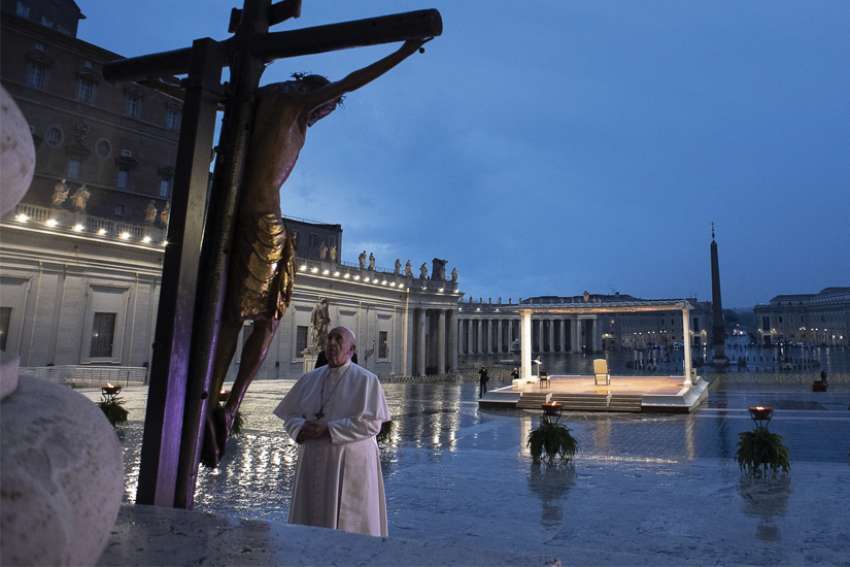I would like to talk more about it. Or at least ask a question that might be answered more or less completely, more or less clearly. What does flying the Pride flag mean?
That needs to be clarified. For example, nobody, despite its name, thinks that it is an endorsement of pride, traditionally first in the taxonomy of deadly sins. A Catholic school would no more fly that sort of pride flag than it would a sloth flag or a gluttony flag.
The Pride flag is about a different sort of pride, pride in one’s identity, like being from Peterborough or Belleville. But it’s not really about hometown pride, either, is it? Otherwise the same flag would not fly in many different cities and countries. So what is it a symbol of?
Symbols can mean more than one thing, but the meaning does have to be specified. For example, the altar at Holy Mass is both a place of sacrifice and a mensa, a table at which we gather for a meal. It has multiple but specific significations.
It is not, for example, a grand ceremonial shelf upon which to display the various medals of the deceased, as was done at the funeral of the late Duke of Edinburgh. They looked splendid, but it was (unintentionally) a literal desecration, taking a sacred place and using it for worldly honours. (That’s why, by the way, I refuse to permit government wedding licences to be placed upon the altar of God.)
Symbols are at the very heart of our faith, symbols which accomplish what they signify. A flag is not a sacrament, but the Catholic sacramental imagination wants to know what symbols mean. So flags are important.
Catholics have a heightened sensibility about flags compared to our fellow Christians. Catholics do not fly national flags on the top of our churches, as some Orthodox churches do. Catholics do not decorate our side chapels with regimental standards, as some Anglican churches do. Indeed, Catholic burial rites do not permit the national flag upon the coffin inside the church; there the funeral pall, representing baptism, is more fitting. I come before the judgment seat of God as a disciple first, not principally as a patriot.
So what does the Pride flag mean? Does it endorse a vision of the human person and human sexuality at odds with divine revelation, biblical witness and Catholic magisterial teaching? Or does it simply indicate an inclusive spirit?
The Archdiocese of Toronto, in an unsigned statement, implied that it took the former view. Other dioceses appeared to be more amenable. The debate at various school boards was marked by much elision and indirection. Ambiguity reigned. Does that mean that the flag means one thing in one place and something else somewhere else?
Hence my desire to talk more about this. Before the Pride flag goes up the pole, the trustees should explain clearly what it does — and does not mean.
Perhaps I might suggest how a parish priest thinks about this. Like all parish priests, I get requests for this or that item, image, ritual or music at a wedding, or funeral, or analogous occasion. If I don’t know what it means, I ask. It may be suitable; it may not be.
Years ago, a bride asked if she might have Aboriginal drumming at her wedding. Growing up in Calgary, I was familiar with the drumming but did not know what it would mean at a wedding. So I asked what the drumming would mean in this context, on this occasion. It turned out the bride didn’t know either. So I proposed that we undertake further study in order to know what we were proposing to do in the house of the Lord. Symbols are important.
The Archdiocese of Toronto noted that every Catholic school already has a symbol of inclusion. The cross was a symbol of ignominy, the sign of domination of one imperium over many subject peoples. Jesus transformed it; when He was lifted up upon it, the reality of what He did made it a symbol of sacrificial love, accomplishing the redemption of the world and the salvation of souls.
There is nothing more universal than our wretchedness as sinners; no cause for pride there. There is nothing more necessary than the offer of salvation in Christ crucified; that truly is our only boast.
So let’s talk about what we are proud of, and what the Pride flag means.
(Fr. de Souza is editor-in-chief of Convivium.ca and a pastor in the Archdiocese of Kingston.)


